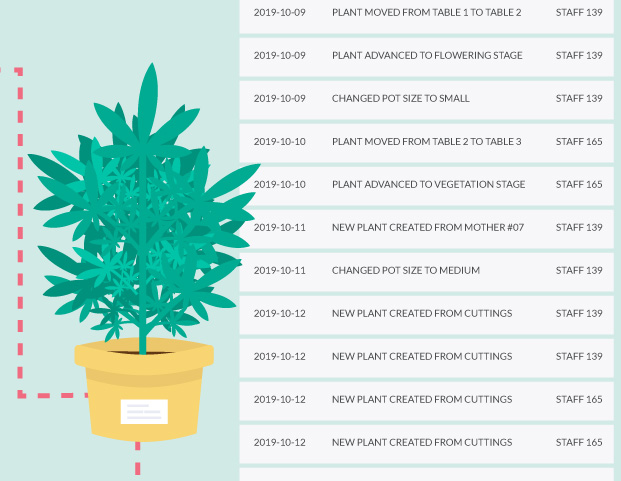
Uncategorized
What is Seed-to-Sale Software?
Have you ever wondered how cannabis travels through the supply chain? “Seed-to-sale tracking” plays an important role in this process, but do you know what it means, or how it works?
For cannabis regulators like Health Canada, supply chain information is crucial to maintaining a safe, compliant, and competitive cannabis industry. This supply chain data is provided to Health Canada by every cannabis licence holder that is operational in the country, thanks to the help of “seed-to-sale” software.
What does seed-to-sale mean?
“Seed-to-sale” is a term unique to the cannabis industry and refers to the tracking and reporting activities that cannabis licence holders are required to follow in order to maintain compliance and stay licensed. Among other things, these requirements help to prevent cannabis from moving between the “black” (or “legacy”) market and the legal market.
Seed-to-sale software is also commonly referred to as cannabis track and trace software or simply cannabis software.
What is seed-to-sale software?
In short, seed-to-sale software helps cannabis companies ensure they stay licensed. From a high-level, this is accomplished by tracking the lifecycle of every gram of cannabis produced and/or processed in a facility, to the point where it is sold, either to a vendor or directly to a medical patient.
Most cannabis regulations only allow you to do specific activities in specific rooms, for example, growing, drying, trimming, and packaging. Considering there are typically thousands of different cannabis plants in a single facility growing at different stages, you may be wondering how it’s possible to track each plant’s movement throughout a single cannabis facility. This is why seed-to-sale software integrates with hardware devices that make the job much easier, like mobile scanning guns, scales, and printers. These hardware integrations, in conjunction with barcodes and tags, make it easy to record and update all related data in a licence holder’s seed-to-sale application.
In addition to improving efficiency, seed-to-sale software is designed to help cannabis businesses easily generate compliance reports for regulatory bodies.
Once all the tracking and sales data is passed to the seed-to-sale application, it’s easy to see an overview of:
- Starting materials (seeds, cuttings, seedlings ), and where they came from
- Total cannabis output (typically measured in kilograms)
- How much was sold (medical patients vs. recreational sales)
- How much was returned and destroyed
Even though the primary purpose of seed-to-sale software is to create reports to keep compliance with cannabis regulations, it captures valuable data that business owners can use to make informed decisions.
Who uses seed-to-sale software?
Cannabis licence holders are the primary audience for seed-to-sale software. This includes standard and micro licence classes for cultivation, processing, medical sales, or a combination of the three. Depending on the software provider, they might only have one version of their software that will cover you from seed to sale, or modular versions of their software that do only what you need them to for your licence type.
For example, some licence holders may only want to grow fresh cannabis and let others handle the processing and selling. For this use case, you do not need to worry about processing, packaging, shipping, or eCommerce, so why would you want to pay for unnecessary software features? This is where modular seed-to-sale software packages can help you get the best business value.
Do you need to use seed-to-sale software?
The use of seed-to-sale software is not required by most cannabis regulators, leaving the cannabis licence holder to decide how they would like to satisfy the strict and complicated reporting requirements. So what are the other options available?
Spreadsheets + carts
Although we haven’t seen this method used for quite some time, it was one of the original ways to capture tracking data before seed-to-sale software existed. Cultivation staff would physically push laptops on metal carts through the grow room as they manually updated a myriad of excel spreadsheets. This manual method was not ideal and is certainly not sustainable now, as many cannabis licence holders continue have scaled their facilities to upwards of one million square feet.
Custom-made software
Custom-made seed-to-sale software is something we have only seen implemented at a few licence holder facilities because building them requires an incredibly large upfront investment — typically at least six figures. For most new licence holders, it would be difficult to justify this investment.
The benefits of custom software include:
- Specifically designing the software for your Standard Operating Procedures (SOPs);
- Applying best practices as you see fit; and
- Dictating employee roles to ensure that your seed-to-sale software does not limit your workflows or ability to report on any metric you want.
Given the extremities of both seed-to-sale software alternatives listed above, almost all cannabis licence holders choose to adopt a seed-to-sale software partner from the start.
But not all software is created equally. Going with a less expensive seed-to-sale software provider with a small implementation fee may seem wise at first, but if employees don’t know how to use it or can’t properly use the platform due to glitches or bugs, you will end up spending much more to switch platforms later on.
The other important aspects of strong seed-to-sale software are security and data accuracy. The former is crucial for protecting private medical patient data, while the latter is key to keeping your licence. It’s not enough to simply use seed-to-sale software. It must be used responsibly and accurately, or your reports could risk having inaccurate data and result in a suspended or terminated licence.